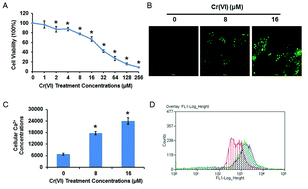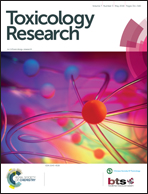The role of IP3R-SOCCs in Cr(vi)-induced cytosolic Ca2+ overload and apoptosis in L-02 hepatocytes
Abstract
Heavy metals such as hexavalent chromium [Cr(VI)] could induce Ca2+ overload and subsequently hepatocyte injury, and even apoptotic cell death, but the source of the increased cytosolic-free Ca2+ is still unclear. The present study aimed to explore the role of an inositol 1,4,5-trisphosphate receptor (IP3R) – store-operated calcium channels (SOCCs) in Cr(VI)-induced Ca2+ overload and apoptosis in L-02 hepatocytes. The cytosolic-free Ca2+ concentration was evaluated using the fluorescent Ca2+ indicator Fluo-4/acetoxymethyl ester (Fluo-4/AM), while Ca2+ concentrations in the mitochondria and endoplasmic reticulum (ER) were detected using the related commercial kits. The gene and protein expression levels of IP3R, sensors’ stromal interaction molecule 1 (STIM1) and pore-forming proteins’ Ca2+ release-activated Ca2+ channel protein 1 (Orai1) were examined using quantitative real-time PCR (qPCR) and western blotting, respectively. Apoptotic cells were examined by flow cytometry. Cr(VI) exposure induced Ca2+ overload and apoptosis in the hepatocytes. By utilizing the IP3R inhibitor 2-aminoethyldiphenylborate (2-APB) and SOCC inhibitor YM-58483, we found that the increase of Cr(VI)-induced cytosolic-free Ca2+ depended on IP3R-mediated Ca2+ release from the ER and SOCC-mediated Ca2+ influx from the extracellular space. We also confirmed that the Cr(VI)-induced extracellular calcium influx (store-operated Ca2+ entry, SOCE) depended on ER Ca2+ release. We reached the conclusion that IP3R-SOCCs played an important role in Cr(VI)-induced Ca2+ overload and apoptotic cell death in the hepatocytes, which will provide experimental evidence for the research on the exogenous chemical-induced Ca2+ overload of hepatocytes, and for the prevention and early treatment of liver damage in a Cr(VI)-exposed population.



 Please wait while we load your content...
Please wait while we load your content...